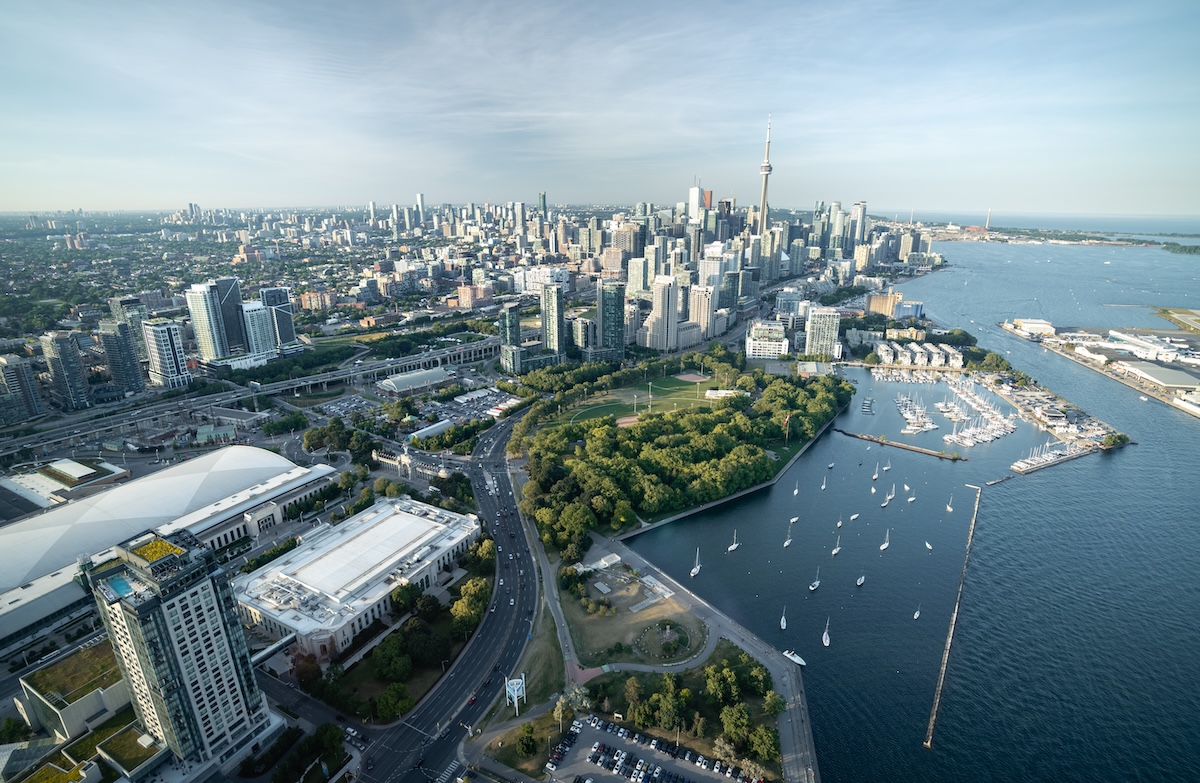Toronto’s iconic skyline is a testament to its growth, ambition, and global appeal. From the soaring CN Tower to sleek skyscrapers dotting the downtown core, the city’s skyline has become a defining feature, symbolizing its status as a thriving hub of culture, business, and innovation.
Toronto’s skyline 2025 is set to evolve dramatically with new developments that are reshaping the city’s landscape. These projects are adding height and redefining the way people live, work, and interact in urban spaces.
With a focus on vertical expansion, mixed-use buildings, and sustainable architecture, Toronto is embracing its future as a world-class city.
Why Toronto’s Skyline Is Changing
Toronto’s skyline is constantly evolving to meet the needs of a dynamic and growing city. Several factors are driving this transformation, from demographic shifts to economic growth and innovative urban planning strategies.
Here’s a closer look at why the city’s skyline is changing.
Population Growth
Toronto’s population continues to grow at a rapid pace, creating a significant demand for housing.
As one of the fastest-growing cities in North America, Toronto attracts thousands of new residents each year, including immigrants, young professionals, and families seeking urban opportunities.
This increasing population density has pushed developers to build upward, resulting in an influx of high-rise residential towers to accommodate the city’s expanding needs.
Economic Growth
Toronto’s thriving industries, particularly tech and finance, are driving the need for commercial development.
As global companies establish headquarters and offices in the city, the demand for premium office space has surged.
These developments add height to the skyline and solidify Toronto’s reputation as a global business hub. Toronto skyscraper developments like the CIBC Square and The Well exemplify the city’s focus on creating world-class commercial spaces.
Transit-Oriented Developments in Toronto
The expansion of Toronto’s transit infrastructure, including new and upgraded GO stations, is influencing where and how skyscrapers are built. Transit-oriented developments prioritise accessibility, placing residential and commercial buildings near key transit hubs. Projects like those along the Ontario Line and Eglinton Crosstown LRT are transforming previously underutilised areas into vibrant, connected neighbourhoods.
Urban Planning Goals
Toronto’s urban planning is guided by goals of density, sustainability, and mixed-use functionality. The city is encouraging developments that integrate residential, commercial, and public spaces into single projects, reducing urban sprawl and promoting walkability. Sustainability initiatives are also shaping new buildings, with developers incorporating energy-efficient designs, green roofs, and other environmentally friendly features.
Major Projects Shaping the Toronto Skyline by 2025
Toronto’s skyline is undergoing a dramatic transformation, thanks to several ambitious projects that aim to redefine the city’s architectural and functional landscape. From mixed-use skyscrapers to residential towers and commercial landmarks, these developments are shaping the city’s future.
Here are some key projects to watch:
Mixed-Use Skyscrapers
Mixed-use developments are at the forefront of Toronto’s urban planning, combining residential, commercial, and retail spaces into single iconic structures. These projects optimize land use and cater to the city’s growing demand for convenience and functionality.
- The One: Set to become Canada’s tallest building at 85 storeys, The One will feature luxury condominiums, a flagship retail space, and high-end amenities. Located at Yonge and Bloor, it’s poised to become a landmark for modern urban living.
- Mirvish+Gehry Towers: Designed by world-renowned architect Frank Gehry, these twin towers will rise in the Entertainment District, offering a blend of residential units, office spaces, and cultural facilities. Their unique design is set to make them a standout feature of Toronto’s skyline.
Residential Towers
To address Toronto’s growing population and housing demand, developers are focusing on high-density residential projects that provide modern living spaces in the heart of the city.
- Sugar Wharf Condominiums: Located on the waterfront, this multi-tower project will add thousands of residential units, bringing new life to the city’s eastern core.
- Forma: Another Gehry-designed masterpiece, Forma will provide luxury residences while contributing to Toronto’s architectural diversity.
Commercial Landmarks
Toronto’s role as an economic hub has driven the development of commercial skyscrapers, offering state-of-the-art office spaces that attract global businesses.
- CIBC Square: This two-tower development near Union Station combines premium office spaces with urban parks and retail areas, creating a hub for commerce and community.
- The Well: Located at Front and Spadina, The Well blends offices, retail, and residential spaces, offering a unique mix of functionality and design.
Upcoming Developments Approved or Under Construction
- Ontario Line Developments: Transit-oriented projects near new Ontario Line stations are bringing high-rise developments to previously underutilised areas.
- Eglinton Crosstown Expansions: New residential and commercial projects along the Crosstown LRT line are revitalising neighbourhoods such as Leaside and Mount Dennis.
These projects are not only adding height to Toronto’s skyline but also introducing innovative designs, sustainable features, and mixed-use functionality that reflect the city’s vision for the future.
By 2025, Toronto’s skyline will be more than a collection of tall buildings—it will be a dynamic symbol of urban growth and innovation.
Architectural Trends in Toronto’s New Skyline
As Toronto’s skyline continues to evolve, new architectural trends are emerging that reflect modern priorities and innovation. These trends emphasize sustainability, multifunctionality, and cutting-edge designs, ensuring that Toronto’s skyscrapers are as forward-thinking as they are visually striking.
Sustainability
Sustainable architecture has become a cornerstone of Toronto’s new developments. Many of the city’s upcoming skyscrapers incorporate energy-efficient designs and green building standards to reduce their environmental impact.
Mixed-Use Spaces
Mixed-use skyscrapers are transforming Toronto’s skyline by combining residential, commercial, and retail spaces within single developments. These projects cater to diverse urban needs while promoting convenience and reducing urban sprawl.
- Live, Work, Play: Developments like The One and Mirvish+Gehry Towers integrate luxury residences, office spaces, and retail outlets, creating vibrant communities in vertical spaces.
- Transit-Oriented Living: Skyscrapers near major transit hubs, like Union Station and the Ontario Line, enable residents to enjoy seamless connectivity to work, shopping, and recreation without relying on cars.
Innovative Designs
Toronto’s new skyscrapers are pushing the boundaries of architecture with unique facades, daring structures, and cutting-edge elements that add a distinctive flair to the skyline.
- Unique Facades: The twisting forms of the Forma Towers and the striking exteriors of the Mirvish+Gehry Towers showcase Toronto’s embrace of bold, unconventional aesthetics.
- Advanced Materials: Developers are using lightweight, durable materials such as glass and steel to create sleek, modern structures.
- Iconic Landmarks: Projects like The One are not only tall but also designed to become landmarks that define Toronto’s urban identity.
The Role of Infrastructure in Skyline Transformation
Toronto’s skyline transformation is closely tied to the city’s evolving infrastructure. Investments in transit and public spaces are influencing the locations and designs of new developments, fostering urban density and connectivity.
Here’s how infrastructure is shaping Toronto’s skyline.
Ongoing Transit Improvements
The expansion of Toronto’s transit network, including projects like the Ontario Line and Eglinton Crosstown LRT, is a driving force behind new skyscraper developments. These projects improve connectivity, making previously less accessible areas attractive for high-rise residential and commercial buildings. For example:
- The Ontario Line is spurring developments near its planned stations, including East Harbour, which will become a major transit hub and mixed-use destination.
- The Eglinton Crosstown LRT is revitalising neighbourhoods along its route, attracting high-density projects in areas like Leaside and Mount Dennis.
Role of New GO Stations
The construction and upgrades of GO stations are promoting transit-oriented developments, with skyscrapers and mixed-use complexes being built near these hubs. For example:
- New GO stations like Caledon and upgrades to existing lines are increasing urban density by encouraging vertical living close to reliable transit.
- These hubs attract residential and commercial developments, catering to commuters who value proximity to transportation options.
Planned Public Spaces
Modern urban developments integrate public spaces into their designs, creating vibrant communities that enhance the city’s livability.
- Projects like The Well include pedestrian-friendly plazas and green spaces, encouraging social interaction and leisure.
- Skyscrapers are being designed with accessible terraces, parks, and urban gardens, providing residents and workers with spaces to relax and connect with nature.
How Will These Changes Impact Toronto Residents?
As Toronto’s skyline evolves, the impact on its residents is significant. From improved housing options to enhanced lifestyles, these changes come with both benefits and challenges.
Increased Housing Supply
The rise of high-density residential towers addresses Toronto’s growing population and housing demand. Benefits include:
- Affordability: Increased housing supply may help stabilise home prices and rental costs, offering more options for buyers and renters.
- Rental Opportunities: Developers are incorporating purpose-built rental units into new projects, catering to a diverse range of residents.
Enhanced Urban Lifestyle
The integration of mixed-use developments and proximity to transit hubs is improving urban living by:
- Convenience
- Employment opportunities
- Community building
Challenges
Despite the benefits, rapid development comes with its share of challenges:
- Congestion
- Construction noise and disruption
- Affordability of new units
Toronto’s skyline transformation is poised to enhance urban living while addressing key challenges. As the city adapts to its growing population and economic needs, residents will experience a more dynamic, connected, and globally competitive urban environment.
Why Toronto’s Skyline Matters on a Global Scale
As the skyline reaches new heights, it reflects Toronto’s rise as a hub for innovation, investment, and cultural significance.
Toronto’s Rising Global Ranking
Toronto consistently ranks among the top cities for global investment, thanks to its stable economy, thriving industries, and diverse talent pool.
With an influx of international businesses and investors, the city’s modern skyline signals its position as a leader in sectors like technology, finance, and green innovation.
Iconic developments such as The One and CIBC Square reinforce Toronto’s reputation as a world-class destination for economic growth.
Tourism and International Appeal
Visitors are drawn to the city’s blend of historic landmarks and cutting-edge architecture, while new residents are attracted by its vibrant urban lifestyle.
Skyscrapers like the Mirvish+Gehry Towers redefine Toronto’s aesthetic and contribute to its cultural and artistic identity, making it a global destination for architecture enthusiasts.
Alignment with Global Smart City Trends
Toronto’s urban development aligns with smart city principles, emphasising sustainability, connectivity, and quality of life. Features such as transit-oriented developments, green building standards, and integrated public spaces showcase the city’s commitment to future-focused growth.
As global cities compete to become leaders in urban innovation, Toronto’s skyline reflects its ambition to stay ahead in the race for sustainability and smart living.
Justo’s Role in Toronto’s Real Estate Boom
Exploring Toronto’s booming real estate market can be complex, but partnering with an experienced team like Justo ensures buyers and investors have the insights and tools needed to succeed.
Expertise in Toronto’s Changing Property Landscape
Whether it’s identifying opportunities in emerging neighbourhoods or assessing the value of new builds and mixed-use developments, Justo offers tailored advice to help clients make informed decisions.
Benefits of Partnering with Justo
- Expert advice on new builds
- Opportunities for investors
- Support for buyers and sellers
Toronto’s Skyline: A Symbol of Growth and Opportunity
Toronto’s skyline transformation is more than just a collection of new skyscrapers; it’s a testament to the city’s growth, ambition, and global significance.
The blend of innovative architecture, sustainable design, and transit-oriented development reflects Toronto’s commitment to creating a vibrant, connected, and forward-thinking urban environment.
As the city continues to rise, so do the opportunities for homeowners, investors, and businesses to be part of this dynamic evolution.
Whether you’re considering a new build, exploring investment options, or looking to buy or sell property in Toronto, understanding the changing landscape is key.
For expert guidance and insights into Toronto’s evolving real estate investment, contact Justo today. With their expertise and client-focused approach, Justo can help you navigate this exciting moment in Toronto’s history and secure your place in its future.
- The Impact of Interest Rate Cuts on Toronto’s Housing Affordability - April 23, 2025
- Bank of Canada Holds Interest Rate Steady Amid Tariff Uncertainty - April 19, 2025
- The Impact of Interest Rate Cuts on Toronto’s Housing Affordability - April 11, 2025




